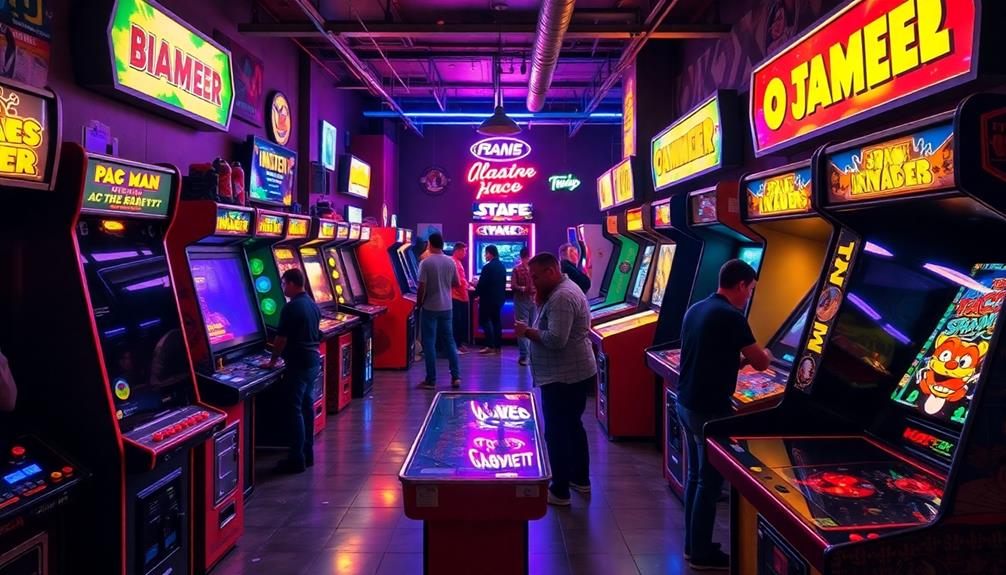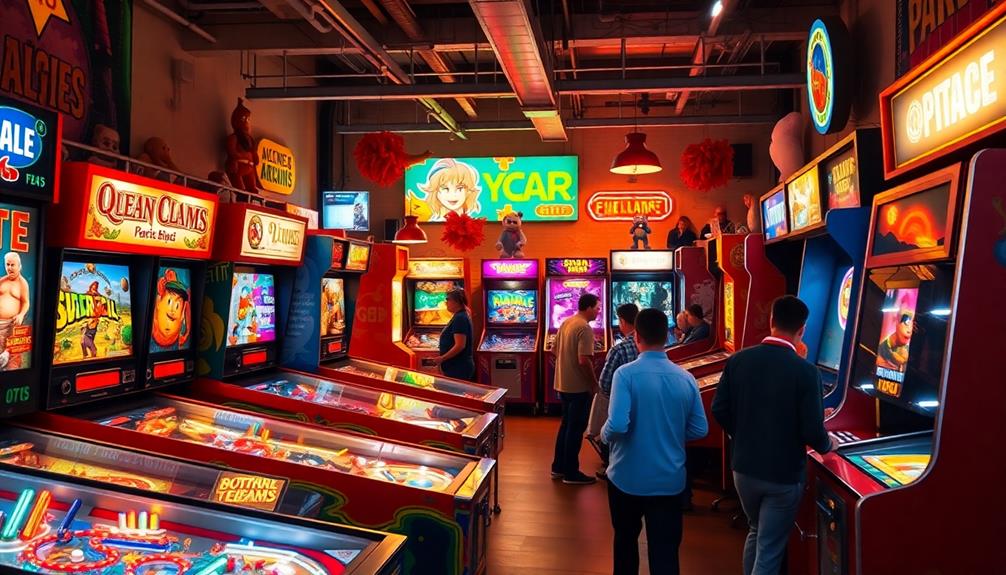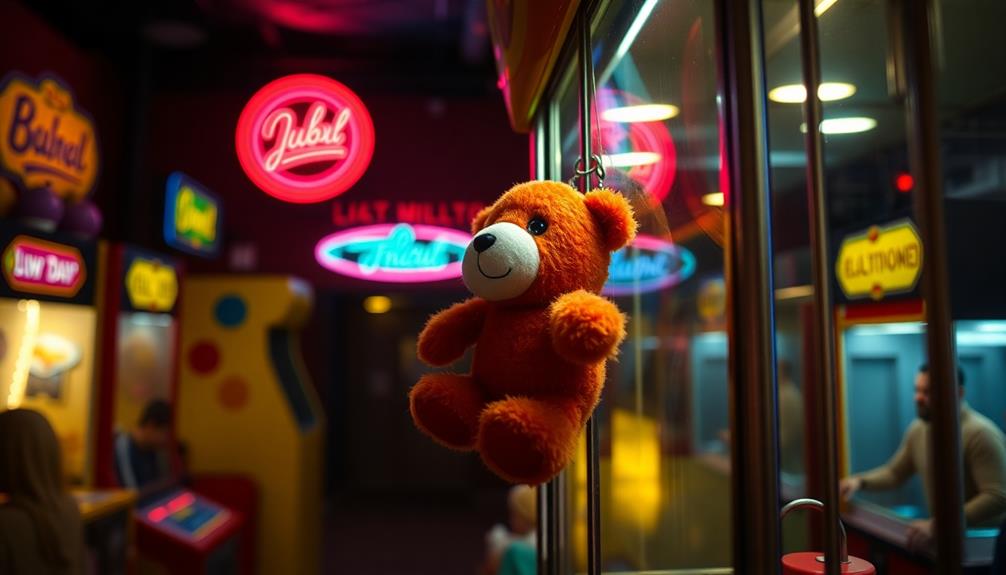When one thinks of popular arcade games, they typically recall classics such as Pac-Man, Street Fighter II, and Space Invaders. Pac-Man provided thrilling maze-chase action, while Street Fighter II introduced innovative characters to competitive fighting. Space Invaders pioneered the shooter genre, captivating players worldwide. Additionally, titles like Teenage Mutant Ninja Turtles and NBA Jam promoted social interactions through multiplayer gameplay. These games have each made a significant impact on gaming culture and history. If you’re interested in delving deeper into the influence of these iconic games, there is much more to discover about their legacies and advancements.
Key Takeaways
- Pac-Man is a cultural icon known for its maze chase gameplay, selling over 400,000 cabinets and generating approximately $3.5 billion.
- Space Invaders pioneered the shooter genre, selling around 750,000 cabinets and grossing $2.7 billion, causing a coin shortage in Japan.
- Street Fighter II revolutionized fighting games, defining competitive gameplay and selling approximately 320,000 cabinets, earning $2.31 billion.
- Ms. Pac-Man expanded the original's success, appealing to a broader audience and generating around $1.2 billion by 1987.
- Teenage Mutant Ninja Turtles and The Simpsons are popular four-player arcade games that enhance social interactions through cooperative gameplay.
Overview of Arcade Games
Arcade games have carved out their own unique space in gaming history, enchanting players with their engaging gameplay and vibrant designs. These games emerged in the late 1970s and early 1980s, marking the Golden Age of arcades. During this period, titles like Space Invaders and Pac-Man not only captivated audiences but also set records as some of the highest-grossing arcade games ever.
With advancements in technology, the evolution of arcade machines has continued, leading to the creation of modern machines that blend classic designs with innovative features, as seen in the best arcade machines for home game rooms.
Space Invaders, launched in 1978, revolutionized the shooter genre and sold around 750,000 cabinets, grossing an impressive $2.7 billion. Just two years later, Pac-Man became a cultural icon, selling over 400,000 cabinets and raking in approximately $3.5 billion.
As arcade gaming evolved, so did its genres. Street Fighter II, released in 1991, established competitive gameplay and defined the fighting game genre, selling around 320,000 cabinets. Meanwhile, Donkey Kong, introduced in 1981, not only debuted Mario but also pioneered platform gaming, selling 132,000 cabinets and generating $280 million.
These games have left an indelible mark on gaming culture, influencing countless titles and keeping players coming back for more.
Iconic Arcade Titles
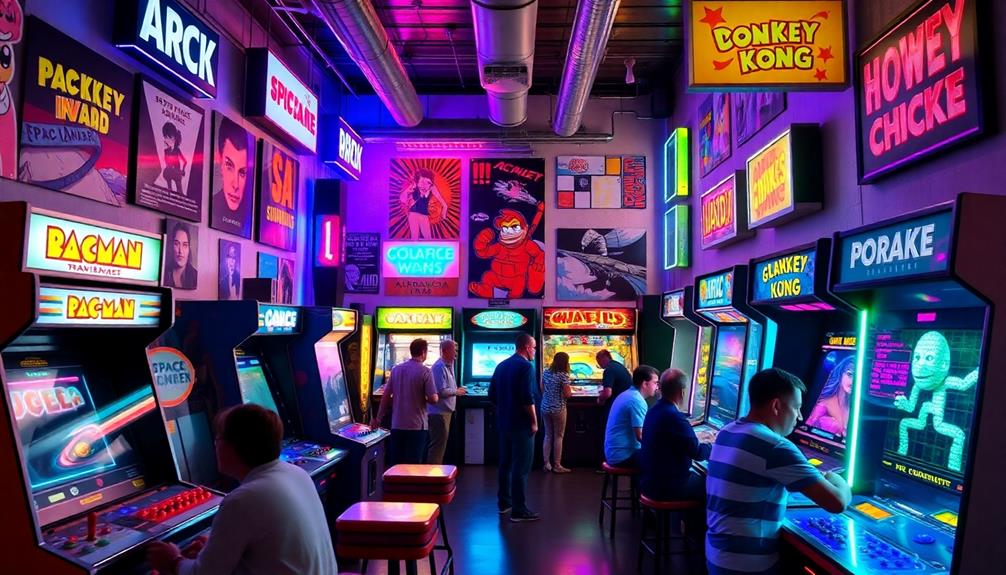
Several iconic arcade titles have left an enduring legacy in gaming, enchanting players and shaping the industry. You can't mention classic arcade games without highlighting Pac-Man. Released in 1980, it sold over 400,000 cabinets and generated around $3.5 billion, becoming a cultural icon and the first major gaming mascot. The game's bright colors and engaging gameplay evoke feelings of joy and nostalgia, much like the themes found in Blue Skies and Lemonade by Rhythm Failure.
Similarly, Space Invaders, launched in 1978, sold about 750,000 cabinets, pioneering the shooter genre and causing a coin shortage in Japan.
Another significant title is Street Fighter II. Released in 1991, it sold around 320,000 cabinets and brought in $2.31 billion, establishing the competitive fighting game genre with innovative mechanics that changed gaming experiences forever.
Don't forget about Donkey Kong, which introduced Mario in 1981 and influenced the platforming genre despite selling only 132,000 cabinets.
Lastly, Ms. Pac-Man expanded on the original's success, selling 125,000 cabinets and earning $1.2 billion by 1987, appealing to a broader audience.
These best-selling arcade games not only entertained but also became staples of popular culture, showcasing the evolution of arcade video games over the years.
Multiplayer Classics

When you gather friends for a gaming session, multiplayer classics like *Teenage Mutant Ninja Turtles* and *The Simpsons* shine with their four-player gameplay.
These games showcase a nostalgic charm that resonates with both new and veteran players, reminiscent of the camaraderie found in high-quality experiences featured in pinball machines.
You'll experience the thrill of iconic character combos as you team up to take down enemies and overcome challenges.
This cooperative fun not only enhances the gameplay but also strengthens your bonds with fellow gamers.
Four-Player Gameplay Experience
Multiplayer classics like Teenage Mutant Ninja Turtles and The Simpsons bring players together for an unforgettable four-player gameplay experience.
These games not only provide engaging gameplay but also foster social interactions in arcade settings, similar to how celebrity friendships, like that of Emma Watson and Tom Felton, illustrate the importance of connection. You can team up with friends, strategizing to defeat enemies and conquer challenging levels.
Here are some highlights of these multiplayer classics:
- Teamwork: Games like Golden Axe encourage cooperative play, letting you and your friends leverage unique character abilities to tackle tough foes.
- Iconic Characters: In X-Men, you can choose from fan-favorite superheroes, each with distinctive powers that enhance the multiplayer experience.
- Humor and Fun: The Simpsons offers a lighthearted atmosphere, filled with humorous animations that keep the gameplay entertaining.
These titles exemplify the joy of four-player gameplay, allowing you to share laughter, triumphs, and even the occasional defeat with friends.
Whether you're battling alongside your favorite turtles or maneuvering through Springfield's streets, the camaraderie formed in these arcade classics is truly unforgettable.
Grab a few friends, choose your characters, and plunge into these engaging multiplayer experiences!
Iconic Character Combos
While teaming up in arcade classics, you'll discover the magic of iconic character combos that elevate the gaming experience. Games like *Teenage Mutant Ninja Turtles* and *The Simpsons* showcase cooperative gameplay, where you can team up with friends to release powerful character combos. Each character has unique moves that complement one another, enhancing your strategies in these beat 'em up titles.
These games often feature vibrant graphics and engaging storylines that draw players in, reminiscent of the emotional speeches that resonate during events like Paula Deen's wedding highlights (memorable moments showcasing love).
In *X-Men*, with the ability to have up to six players join simultaneously, you can really immerse yourself in multiplayer experiences that emphasize teamwork. The dual screens add to the excitement, allowing you to coordinate your moves effectively.
Similarly, *Golden Axe* offers a fantasy twist, where each character's magical abilities can create devastating combos that not only clear the screen but also solidify your status in competitive gaming.
These iconic games foster a spirit of collaboration, with players relying on each other's strengths to overcome challenges. Whether you're launching into a combo with a friend or strategizing in the heat of battle, the character combos in these arcade games create unforgettable moments that keep you coming back for more.
Innovative Gameplay Mechanics
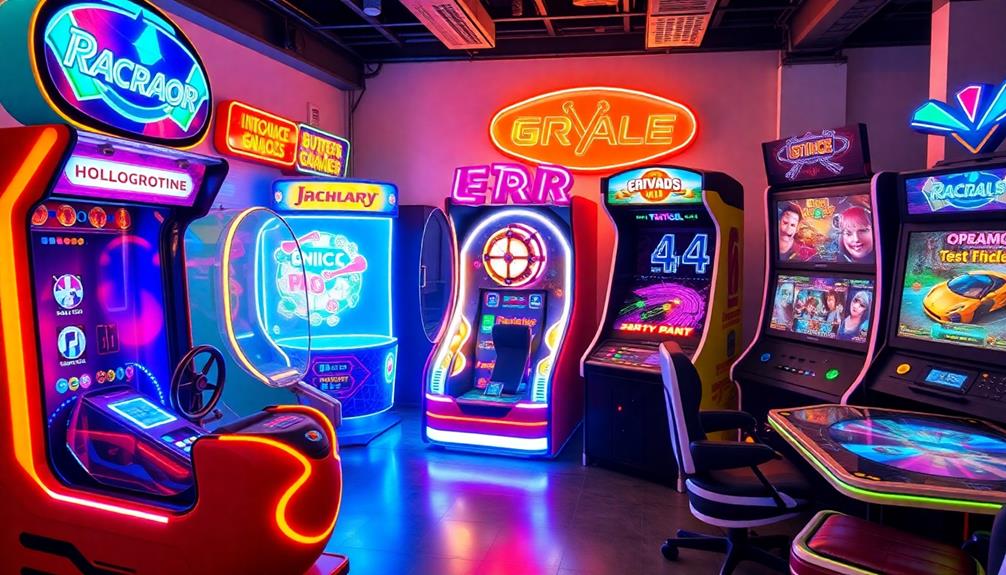
Innovative gameplay mechanics have transformed the arcade landscape, enchanting players with fresh experiences. Take a moment to appreciate how these games have redefined what it means to play in arcades.
For instance, Defender (1981) combined traditional shooting elements with wave-based combat, requiring you to rescue humanoids while battling aliens. Similarly, Ikari Warriors (1986) introduced dual-stick shooting, granting you better control over movement and firing as you navigate enemy territory with friends. This evolution in gameplay mirrors the way astrology influences attractiveness by adding layers of complexity to player experience.
Not to be overlooked, Guitar Freaks (1998) shifted the focus of music games from real musicianship to fun button pressing, paving the way for rhythm games in arcades. Meanwhile, Time Crisis II (1997) perfected lightgun gameplay by incorporating a foot pedal for strategic cover, enhancing the cooperative experience.
Finally, Joust (1982) popularized competitive gameplay with knights riding flying ostriches, showcasing exceptional innovative design.
Here are a few standout features of these games:
- Unique mechanics that challenge your skills
- Cooperative and competitive play options
- Engaging strategies that keep you coming back
These innovative gameplay mechanics keep arcade gaming alive and exciting!
Influential Pioneers

When you think about the origins of arcade games, several influential pioneers come to mind. From early innovations that shaped gameplay to cultural icons that defined an era, these games set the stage for everything that followed.
The enchanting nature of these titles not only engaged players but also created a community around gaming, leading to increased sales and brand loyalty.
Understanding the importance of data-driven strategies can also provide insight into how these pioneers effectively captured the attention of audiences.
Let's explore how these groundbreaking titles changed the gaming landscape forever.
Early Game Innovations
The evolution of arcade games owes much to a handful of pioneering titles that changed the landscape of gaming forever. It all started with Computer Space in 1971, the first commercial arcade machine that paved the way for future innovations.
Then came Pong in 1972, which popularized the arcade format and became an iconic game that shaped home console markets. The integration of sound effects in these early games laid the groundwork for future innovations in music therapy integration, enhancing player engagement and emotional responses.
Space Invaders (1978) marked the beginning of the Golden Age of Arcades, introducing unique enemy movement patterns that captivated players and created a coin shortage in Japan.
Following that, Pac-Man (1980) became a cultural phenomenon, establishing the maze chase gameplay and becoming the first major gaming mascot. It influenced countless sequels and merchandise, leaving an indelible mark on the industry.
Lastly, Donkey Kong (1981) introduced Mario and laid the groundwork for the platforming game genre, solidifying Nintendo's success. These early game innovations not only entertained players but also set the stage for the arcade machines that are familiar to us today.
- Each game introduced unique mechanics.
- They shaped gaming culture and home entertainment.
- Their influence continues to resonate in modern gaming.
Cultural Impact Highlights
Numerous iconic arcade games have left a lasting cultural impact, reshaping the gaming landscape and influencing generations of players. Pac-Man, introduced in 1980, became the first major gaming mascot, appealing to a broad audience and generating over $3.5 billion in revenue by 1990. This cultural phenomenon led to a surge in merchandise and media, demonstrating how even in gaming, trust issues with boyfriends can reflect deeper emotional connections.
Before that, Space Invaders, released in 1978, kickstarted the arcade era, creating a coin shortage in Japan and earning $2.7 billion in revenue.
In 1991, Street Fighter II revolutionized the fighting game genre and established competitive gaming culture, with sales reaching 320,000 cabinets and generating $2.31 billion. Additionally, Donkey Kong launched Mario as a character and introduced platforming gameplay, while Ms. Pac-Man expanded on its predecessor's success by attracting female players through innovative maze designs, earning $1.2 billion by 1987.
Together, these games not only defined their respective genres but also left an indelible mark on gaming culture, encouraging a passion for arcade gaming and setting the stage for future innovations. Their influence still resonates with players today.
Racing and Sports Games

While you might think of arcade games as simple entertainment, racing and sports games have pushed the boundaries of excitement and competition in the arcade scene. These games offer thrilling gameplay that keeps you on the edge of your seat, providing a perfect blend of skill and fun.
Many of these adrenaline-pumping experiences can be found at family-friendly destinations, such as hotels with water parks that often feature arcade games as part of their entertainment offerings, making them great for kids and adults alike family-friendly amenities.
Consider these iconic titles:
- Sega Rally: This 1994 classic introduced force-feedback steering wheels, making muddy track racing feel incredibly realistic.
- NBA Jam: Launched in 1993, this game revolutionized sports gaming with its 2-on-2 matches, featuring real NBA teams and generating over $1 billion in revenue.
- Daytona USA: Known for its multiplayer capabilities, you could race against up to eight friends, turning any arcade visit into a competitive showdown.
Games like Cruis'n USA and Out Run also contributed to the racing genre's allure, with fast-paced mechanics and immersive experiences.
Whether you're speeding through vibrant graphics or enjoying the over-the-top action of NBA Jam, racing and sports games in the arcade offer an adrenaline rush unlike any other.
Fighting Game Legends
Fighting games have carved out an iconic place in arcade history, enthralling players with their intense competition and memorable characters. Among these legends, *Street Fighter II* stands tall, often hailed as the best fighting game of all time. It revolutionized competitive gaming with its special moves, selling around 320,000 cabinets and raking in $8.5 million.
Then there's *Mortal Kombat II*, known for its over-the-top violence and unique character selection. It sold around 27,000 cabinets, amassing approximately $600 million by 2002.
The *Tekken Series*, launched in 1994, captivated fans with its 3D graphics and character depth, while the *Marvel vs Capcom Series* popularized tag-team mechanics, creating a dedicated competitive community. Finally, the *King of Fighters Series*, debuting in the same year, introduced a unique three-on-three battle format, attracting loyal fans and a strong tournament presence.
Here's a quick look at these arcade hits:
| Game Title | Release Year | Unique Feature |
|---|---|---|
| Street Fighter II | 1991 | Accessible special moves |
| Mortal Kombat II | 1993 | Over-the-top violence |
| Tekken Series | 1994 | 3D graphics and character depth |
| Marvel vs Capcom | 1998 | Tag-team fighting mechanics |
| King of Fighters | 1994 | Three-on-three team battles |
Lightgun and Shooting Experiences

Since the mid-1990s, lightgun and shooting games have captivated arcade enthusiasts with their immersive gameplay and thrilling action.
These games offer a unique blend of fast-paced shooting and interactive experiences that keep players coming back for more. You can step into the shoes of a daring hero, battling everything from dinosaurs in Jurassic Park: The Lost World to zombies in House of the Dead 2. The excitement of precision shooting in these horror-themed arcade adventures creates an unforgettable atmosphere.
Here are some standout features you might love:
- Co-operative play: Team up with friends for an enhanced experience, especially in games like Time Crisis II where strategic cover becomes essential.
- Rail shooter format: Games such as The Gunblade NY immerse you in action-packed scenarios, controlling helicopters and taking down enemies.
- Branching paths: Virtua Cop 2 challenges your skills with multiple routes, making each playthrough unique.
Lightgun gameplay allows you to engage in heart-pounding moments, making these arcade games a must-try for anyone looking for excitement and fun.
Unique Gameplay Concepts
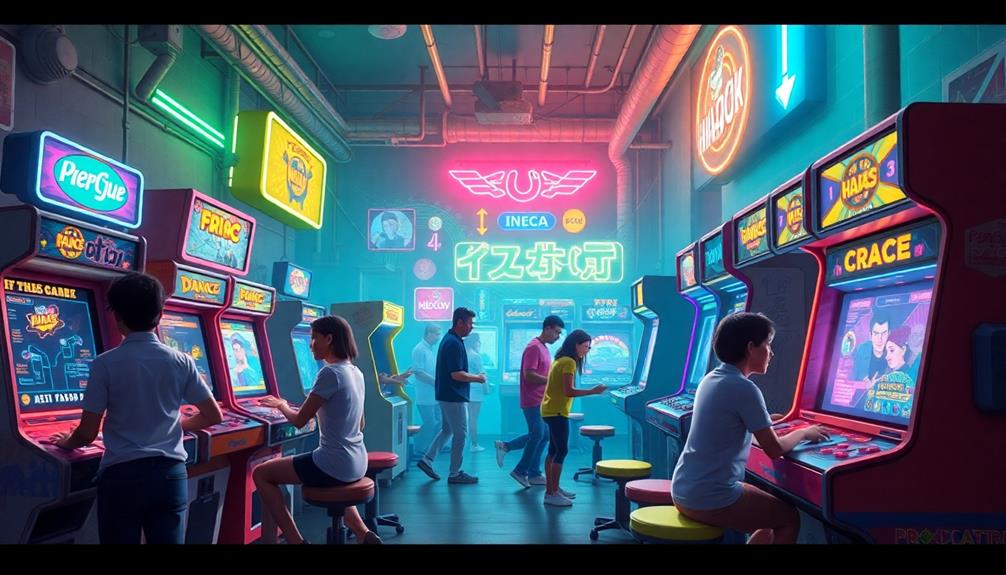
Unique gameplay concepts have always pushed the boundaries of what arcade games can offer, creating memorable experiences that stand out in players' minds.
Take Joust (1982), for instance; it popularized two-player competitive gameplay with its quirky knights riding flying ostriches, demanding skillful maneuvering to outmatch your opponent.
Meanwhile, Dance Dance Revolution (1998) revolutionized the rhythm action genre, using a dance mat to engage players physically while they step in time with the music—this was a game changer for retro arcades.
Guitar Freaks (1998) shifted the focus of music-based arcade video games towards button pressing, paving the way for a wave of future plastic instrument games.
Then there's Cho Chabudai Gaeshi! (2009), which challenged players to flip a full-sized table in-game, showcasing how creative game design can lead to unique gameplay experiences.
Finally, Time Crisis II (1997) perfected the duck-and-shoot mechanics of lightgun games by adding a foot pedal for strategic cover, simultaneously enhancing cooperative gameplay.
Each of these titles highlights how innovative mechanics can redefine action games and elevate player engagement in mechanical machines found in arcades.
The Legacy of Arcades

Arcades have left an indelible mark on the gaming landscape, shaping not just the industry but also our culture. From the late 1970s to early 1980s, games like *Pac-Man* and *Space Invaders* became cultural phenomena, generating billions in revenue and influencing gaming history. The arcade industry peaked in 1982, with thousands of establishments and millions of machines, surpassing even pop music and Hollywood films.
The legacy of arcades is evident in several ways:
- Introduction of New Genres: Games like *Street Fighter II* laid the groundwork for competitive gaming and the fighting genre.
- Nostalgia Factor: Today's gamers often reminisce about the social experiences and communal atmosphere of arcades.
- Enduring Popularity: Classic titles continue to inspire sequels and spin-offs, keeping arcade games alive in modern culture.
This gaming legacy not only transformed gameplay mechanics but also fostered a competitive spirit that resonates to this day.
Whether you're revisiting an old favorite or exploring new titles, the influence of arcades shapes your gaming experience in profound ways.
Frequently Asked Questions
What Is the Most Common Arcade Game?
When you think about the most common arcade game, Pac-Man instantly comes to mind. Released in 1980, it sold over 400,000 cabinets and generated billions in revenue, making it an iconic staple of gaming culture.
Which Is the Best Arcade Game?
When considering the best arcade game, you might lean towards classics like Pac-Man or Street Fighter II. Their timeless gameplay and cultural impact capture gamers' hearts, making them unforgettable experiences in the arcade world. However, there are also other popular arcade games that deserve recognition for their contributions to the industry. Titles like Dance Dance Revolution and Time Crisis have also left a lasting impression on arcade enthusiasts, offering unique and immersive gameplay experiences that have stood the test of time. These popular arcade games have helped shape the landscape of the arcade industry, and continue to attract players of all ages.
What Is the Highest Selling Arcade Game of All Time?
The highest selling arcade game of all time is *Pac-Man*, with 400,000 cabinets sold and an estimated revenue of $3.5 billion. Its iconic status and gameplay have left a lasting impact on gaming culture.
Which Classic Arcade Game Do People Love Most?
You've gotta love Pac-Man! It's the classic arcade game that's captured hearts for decades. With its iconic maze and relentless ghosts, it's no wonder people still rave about this nostalgic favorite today.
Conclusion
In the vibrant tapestry of gaming history, arcade games stand as shimmering gems, each one a portal to nostalgia and adrenaline. You've journeyed through iconic titles and thrilling multiplayer experiences, discovering the heart and soul of the arcades. As you step away from the joystick, remember that these games aren't just relics; they embody the spirit of innovation and camaraderie, inviting you to relive the magic whenever you hear the familiar chime of a coin slot.
